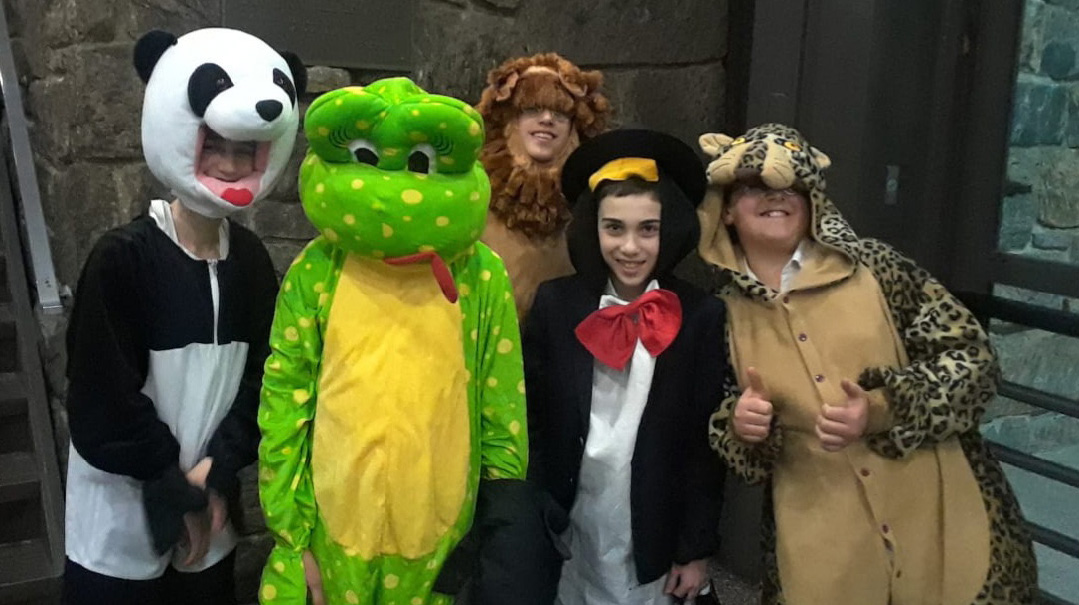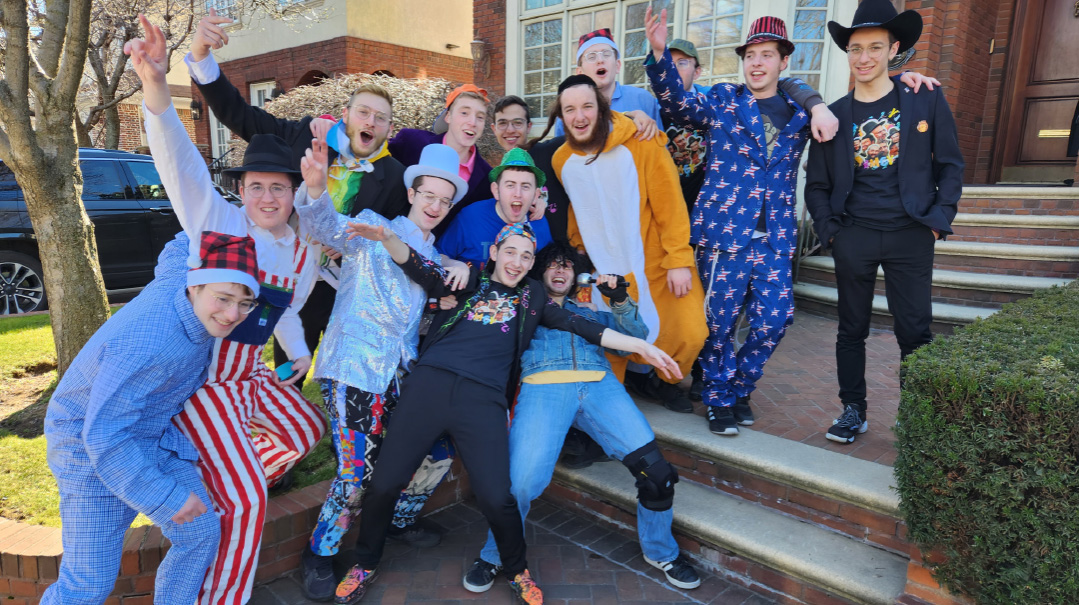Door to Door
| March 19, 2024The serious logistics behind the happy dancing of Purim collectors

Photos: KYT Archives
It’s an iconic Purim scene in frum communities all over: happy teenaged bochurim, sporting eye-catching costumes and hoisting speakers blaring lively music, merrily dance their way into local houses to collect funds for a worthy cause. While it may seem spontaneous fun, there’s serious logistical work that takes place in the weeks before Purim. Brooklyn-based Aaron Schilit, who has been involved in managing the back end of Keren Yitzchok Tzvi’s collector crews since high school, shares how he ensures a smooth operation — and that no boy gets stumped when a well-meaning philanthropist asks for a devar Torah.
ON what KYT is
Thirty-eight years ago, Rav Avraham Pam ztz”l, rosh yeshivah of Torah Vodaath, founded Keren Yitzchok Tzvi — or as we refer to it, “KYT” — l’ilui nishmas Yitzchok Tzvi Perlman a”h, a talmid of the yeshivah who was niftar at a young age. Rav Pam encouraged talmidim of the yeshivah to go around on Purim and collect for KYT. The money was designated for kiruv-related projects, and every year, a different kiruv institution would be the beneficiary of the funds raised.
One year the funds went toward the renovation of a beis medrash in a kiruv school in Ashkelon, another year it was an elementary school classroom in Hadera. Many of the schools receiving our funds have memorialized our contributions with a plaque recognizing the “KYT Purim Campaign.” One plaque even lists the names of the bochurim who were in the group that brought in the highest total from that year’s campaign.
When the bochurim knew they had a specific project they were aiming to cover, and that the money they raised wasn’t just getting absorbed into an operating budget somewhere, it really motivated them, because they knew every dollar was going toward actualizing something specific.
ON where the money goes now
Twelve years ago, Torah Vodaath rosh yeshivah Rav Yisroel Belsky wasn’t well, and Rav Yisroel Reisman, a talmid of Rav Pam who had succeeded his rebbi as the leader of the Keren, decided to use the funds for hachnassas kallah and to dedicate the zechus generated for Rav Belsky’s refuah sheleimah. Rav Reisman quoted the mishnah of “Eilu Devarim,” which discusses the mitzvos for which a person receives the residual benefits in this world while the principal reward awaits in the World to Come. The mishnah lists “bikur cholim, hachnassas kallah, levayas hameis.” Rav Reisman suggested, based on a vort from the Steipler, that the sequencing alludes to the fact that the zechus of hachnassas kallah can stand between a choleh and a meis, and the yeshivah established the KYT Hachnassas Kallah Fund to help the yeshivah’s needy chassanim and yungeleit making chasunahs.
Baruch Hashem, Rav Belsky fully — and miraculously — recovered from that illness and came back to the yeshivah, which he led until his petirah four years later.

ON how our operation works
We divide the eighth grade and high school talmidim (depending on the year, ranging from about 160 to 180 boys) into about 25 groups, about five to eight boys each, and they go door-to-door here in Brooklyn on Purim night and day, asking for donations. A beis medrash bochur accompanies every group and serves as their driver.
One boy is designate d as the “group leader,” and he gets a folder with the list of addresses on the group’s route, some brochures with literature about KYT for anyone who wants more information, receipts, and a pencil case to hold the cash and checks. We also include some short divrei Torah in case a prospective donor asks for one.
By now we have the schedule down to a science. On Taanis Esther, the program starts: We daven Minchah in the mesivta beis medrash, followed by a learning seder and a Purim-related shmuess, then Maariv, Krias Megillah, and a break-fast meal. This way, everyone is in the same place, and we can hit the roads without wasting time.
Purim in Brooklyn is leibedig; the streets are full of dancing boys and men, everybody is dressed up, and the atmosphere is festive — and the colorful groups of bochurim collecting tzedakah is a major part of the unique Purim vibe. The whole matzav is a real win-win; money is being raised for a good cause, balabatim are happy to give, they and their families love the ruach the bochurim bring to their homes, and the boys have a great time facilitating it all.
ON keeping overhead down
The campaign is fully staffed by volunteers and bochurim; no one takes a commission. Aside from renting cars to get the groups around, we don’t have any overhead. As for the cars themselves, we stick to minivans and SUVs. The boys have a wholesome and fantastic time even without the “cool” cars, and they know that our overhead is kept to an absolute minimum and that the money they are working hard to collect is actually going straight to tzedakah.
Recently, I mentioned to Rav Reisman that we’d need to replace one of the computers in our office. He asked me to find out how much a new one would cost, so he could find a donor rather than taking money from what we raise on Purim.
ON how we prepare the bochurim
On Rosh Chodesh Adar, our campaign is kicked off in earnest when our logistics team — which includes volunteer sign hangers, collage makers, typists, technical help, and admin staff — starts working on creating a buzz by hanging posters around the yeshivah’s lobby. Then, beis medrash bochurim — who serve as volunteer campaign coordinators — go around to the eighth grade and high school classes and get the boys excited about Purim collecting. Usually, the menahel also goes into the eighth grade and explains the zechus of being part of this great mitzvah.
Lastly, our coordinators give the boys a step-by-step tutorial: what to sing, when to dance, and general etiquette tips such as not being too pushy, not opening the check before they leave a house, and saying thank you. The coordinators let the boys form the groups themselves, and often follow up to make sure no one is left out.
ON creating routes
After the boys form groups, they are asked to create lists of people who they would like to collect from on Purim — think cousins, grandparents, family friends. We then take all the lists, type up the information, and form a comprehensive list for each group, which includes all the addresses given in by each of its members. We then use that information to create a route, factoring in details like proximity and which bochur would be best to visit a specific donor. Usually, once the routes are set, we add some of our own addresses. Some donors even reach out to us to make sure that a group will stop by their house, and we obviously do our best to accommodate.
ON divvying up the jobs
Aside from the older bochur who serves as the driver, we specifically don’t assign roles within the groups. It’s amazing to see how the boys just take on roles in each group. There’s the loud guy who’s always the first to start belting out “V’nahapoch Hu” or “Layehudim” as soon as the door is opened. There’s the guy who pulls the host into the middle of the circle, and maybe his kids too. There’s the guy who’s always prepared to whip out a vort or just talk Torah, and of course the talker who makes the pitch for a nice donation.
And it’s always great to see how some boys take on the most unexpected of roles — there is something about the Purim spirit that could take a boy who is on the quieter side all year and transform him into the most geshmake, talkative bochur in the group.
And of course, there are the other characters: the guy who sticks out like a sore thumb because his group’s costume clashed with his family’s theme, and he opted for the family one. The guy who spends most of the time on the phone engaging in a combination of financial analysis and Mossad-like surveillance tracking, determining precisely the best time and location to “catch” his wealthy uncle and estimating just how much he can afford to give that year. The bochur whose family Seudah starts at 4 p.m., so he spends his morning sweating about whether he’ll make it back on time for washing. The future actuary who is trying desperately to come up with reasons why, relatively speaking, his group broke the record per capita for money raised — “If you calculate time spent in traffic….”

ON our costumes
When KYT started, all the groups wore clown costumes, but once that became passé, a family that has sent three generations of talmidim to the yeshivah and is in the prison supply business graciously provided bright-orange prisoner uniforms for the boys. They were emblazoned with “Property of Keren Yitzchok Tzvi,” and looked like the real thing. For a while, those iconic jumpsuits were the KYT trademark, until a few people raised the concern that it might be insensitive to have boys prancing around in inmate uniforms. Now we encourage each group to get creative and do its own thing. In recent years, we’ve seen many onesies, cowboys, pirates, construction workers, zoo animals, Uncle Sams — last year there was a group of avocados — and some groups where each boy puts on the most outlandish clothing he found at the local thrift shop.
Usually, things work out… except when they don’t. Once a group decided to dress up in the blow-up costumes that make it look as if the wearer is riding a horse. Well, it’s a cute costume, but mighty hard to maneuver around in, very impractical when going in and out of a minivan — and even harder to dance in. That year, the boys ended up sticking to their costumes half-deflated just to be able to move, so bochurim have shied away from that genre ever since.
ON memorable donations
We generally try to avoid double dipping, but sometimes donors don’t mind. One fellow gave ten checks to ten separate KYT groups last year. Not all the checks were the same amount — they got progressively lower — but he still kept on giving.
Many groups make a few stops where they don’t focus on collecting money but just on being mesameiach Yidden who are elderly, unwell, or just plain lonely. In one such home, the group wasn’t expecting a donation, and suddenly the woman gave them a check for $360. Another time, a group went to Boro Park, and at 1 a.m., when they were in the van heading back to Flatbush, they noticed a chassid walking out of his home to take out the garbage. A bochur rolled down the window and wished him a freilechen Purim, to which the man responded by wordlessly walking over, garbage bag in hand, and handing him a 100-dollar bill.
ON how one mitzvah leads to another
There are a few balabatim in Flatbush who are known to give generously on Purim, but first insist that the boys asking for tzedakah take on a kabbalah in ruchniyus. I’ve seen boys make a kabbalah to not miss minyan for the next year, or commit to come at least ten minutes early to Shacharis for a full year. It’s incredible seeing teenagers pushing themselves to keep these commitments months after Purim.
ON how to make the best of a situation
There was one year that a van full of bochurim got stuck going down one of Flatbush’s one-way streets behind a slow-moving garbage truck. Instead of stewing in frustration, the boys took a two-pronged approach: Half the boys got out of the car and began approaching the other waiting cars, panhandler style. Meanwhile, the other half of the group volunteered for the NYC Sanitation Department and helped some very grateful sanitation workers get that block done in record time.
Every year we hang up posters before Purim with photos of the previous year’s groups, and one of the photos that always gets a lot of attention is the one of a bochur in full Purim regalia pulling the lever of an NYC garbage truck.
$150
The average donation. Although our bochurim tend to remember the higher checks, the smaller donations — $5, $10, or $18 — add up as well.
$5,000
The largest single check a group ever received (though a few people are tied for this record).
$7,200
The largest amount an individual donor gave over one Purim (to several groups who visited his home).
$16,054
Last year’s group record
$80,000 – $100,000
The range of the total we collect every Purim for KYT.
(Originally featured in Mishpacha, Issue 1004)
Oops! We could not locate your form.







